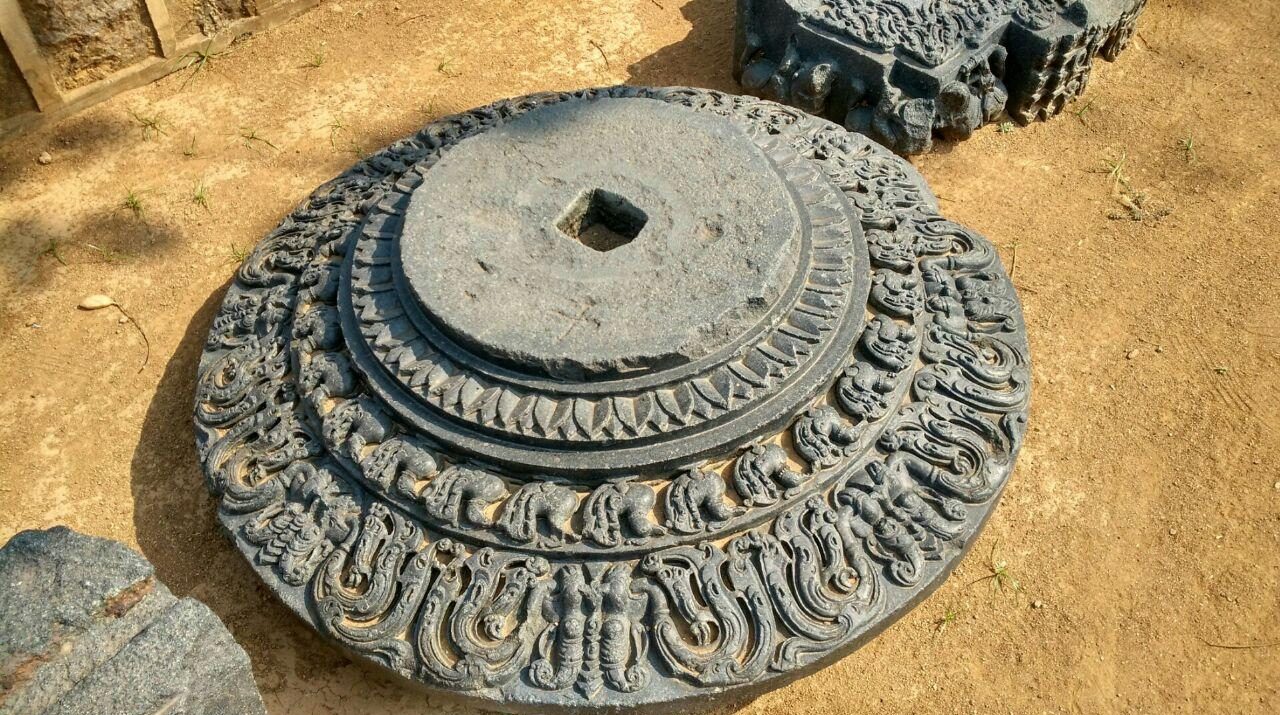#Didyouknow that the river Ganga has been personified as a Goddess? She is worshipped by Hindus from all over India. She is depicted as a beautiful woman in art. Bathing in the Ganges cleanses us of all sins and she is considered holy and the water very pure. There are many legends surrounding Ganga. Ganga is mentioned in the Rigveda. The Bhagavata purana tells us the story of the birth of the Ganges. Lord Vishnu in one of his incarnations is Vamana. When Lord Vishnu as Vamana extends his feet to measure the universe, his big toe inadvertently pierces the end of the universe. Through this hole pure water entered as the River Ganga which finally descended on earth after the request of Bhagiratha to Brahma, but held captive in the locks of Lord Shiva, in order to prevent destruction of the earth by sheer force of Ganga. She was released from the head of Shiva and flows on the land.
A relief at Mahabalipuram depicts the descent of Ganga. It is a part of the group of monuments at Mahabalipuram. An early sculpture of the 7th century, a legacy of the Pallava dynasty attributed to Narsimhavarman I (630 -668 A D.). The relief on stone faces east is skillfully carved. There is a large perpendicular fissure which is in between two boulders. There are over 100 figures on the relief including Gods, Goddesses, humans, half humans, ganas, animals etc. This great cosmic event of Ganga descending on earth is captured here. Its seems as if everyone is watching this event. Mythical figures ganas, Kinnaras, Nagas are also present. Lord Shiva is seen near the Kinnaras. Bhagiratha is doing penance on one leg. Ganga is seen in an anthromorphic form of human and serpent. Nagas too can be seen swimming . the elephants both male and female and smaller ones too are prominent in the relief.

By Ssriram mt (Own work) [CC BY-SA 3.0 (http://creativecommons.org/licenses/by-sa/3.0)%5D, via Wikimedia Commons

By en:Karl Siegfried Döhring (1879 – 1941) (Karl Döhring, Indische Kunst, Berlin 1925) [Public domain], via Wikimedia Commons
Another legend maintains that a king named Sagara performed the ritual Ashwamedha yagna and Lord Indra who is the king of the heavens got extremely jealous and stole the horse and left it at sage Kapil hermitage. King sagar had 60,000 sons and sent them in search of the horse. Kapil got terribly angry when he opened his eyes after meditation and burnt the 60,000 sons of King Sagara to death. The souls of the sons wandered as spirits. Anshuman, the grandson of King sagara pleaded with the sage. He asked him to bring the sacred Ganga down from the heavens. Dilip, who was Anshuman’s son prayed to Lord Brahma but failed. His son Bhagiratha managed to appease Brahma who then ordered Ganga to descend to earth. She however felt insulted and vowed to crush earth with her force. Bhagiratha then prayed to Lord Shiva. Shiva trapped her in his matted locks further sanctifying her and finally let her out as five streams namely Bhagirathi, Jahnvi, Bhilangana, Mandakini, Rishiganga, Saraswati and Alakananda. Following this Bhagirathi leads her to his ancestors to purify their souls and thus release them.

Sculpture of Ganga, Ellora
By Chinmaya Panda (Own work) [CC BY-SA 3.0 (http://creativecommons.org/licenses/by-sa/3.0)%5D, via Wikimedia Commons
The figurines of Ganga and Yamuna are present at the entrance of Rameswara, the cave no: 21 of the Ellora caves. Goddess Ganga’s left hand rests on the head of an attendant. Ganga and Yamuna represent the moon and the sun. Ellora is located 28 km from Aurangabad in the present day Maharastra. The caves were carved out of the Charanandri Hills between 5th and 10th centuries by the Rashtrakuta and Yadava dynasties. Out of the 34 caves 17 are Hindu, 12 Buddhist and 5 Jaina Caves.
The Goddess Ganga stands on her mount, the makara or crocodile, with a kumbha/pot full of water. Her lady attendant is holding an umbrella over her. This image is from the Gupta period made in terracotta found in Uttar Pradesh, Ahichhatra, now kept in the National Museum, New Delhi.

“Teracotta made Ganga of Gupta era 01 at National Museum, New Delhi” by Nomu420 – Own work. Licensed under CC BY-SA 3.0 via Commons – https://en.wiki2.org/wiki/File:Teracotta_made_Ganga_of_Gupta_era_01_at_National_Museum,_New_Delhi.jpg#/media/File:Teracotta_made_Ganga_of_Gupta_era_01_at_National_Museum,_New_Delhi.jpg
The other legend surrounding Ganga is the one relating to her being referred to as Jahnvi. When Ganga came to earth she disturbed the penance of Sage Jahnu. He got angry and drank all the waters of Ganga. The Gods then prayed for her release which pleased him and thus she came to be known as Jahnavi, daughter of Jahnu.
An excellent symbolic representation can be seen in the famous fort of Gwalior in Madhya Pradesh.The fort at Gwalior has a long history. It stands at 300 feet above the plain lands and it is believed to have been King Suraj Sen of the Kacchhappa dynasty who was cured of leprosy by being directed to a pond by Sage Gwalip after whom the town is named. Inside the fort’s courtyards one can see the kumbha on top of the first tier of the pillar.

Courtyard, Gwalior Fort
Pic : Soma Ghosh

Goddess Ganga, 19th-20th century, Kalighat painting, Kolkata.
By Unknown – The Bodleian Libraries, Oxford, CC BY 4.0, https://commons.wikimedia.org/w/index.php?curid=41948606
References :
Ganga and Yamuna : river Goddesses and their symbolism in Indian temples/Heinrich von Stietencron, Permanent Black, Ranikhet,2010.
Posted by : Soma Ghosh
©author
